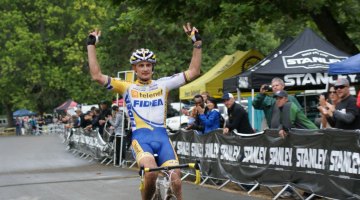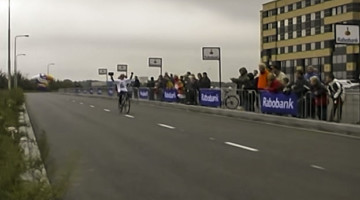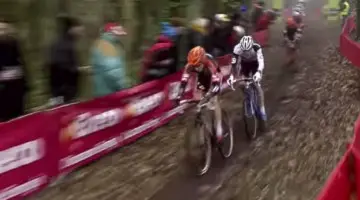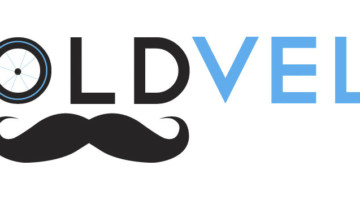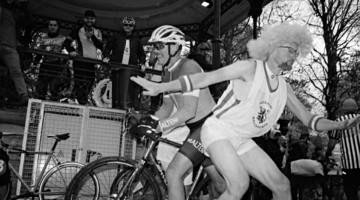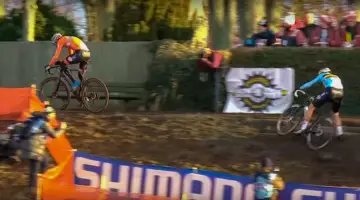by Brandon Grant and Andrew Yee
Alan is a brand with a long history in cyclocross. It started producing frames in 1972 and has since claimed 20 world championships. Old-timers may associate the brand with the alloy glued-and-screwed frames that once dominated cyclocross. Over the years, Alan has produced plenty of champions and frames for other brands. When Don Myrah returned to cyclocross, he did so on his Alan-built Guerciotti.
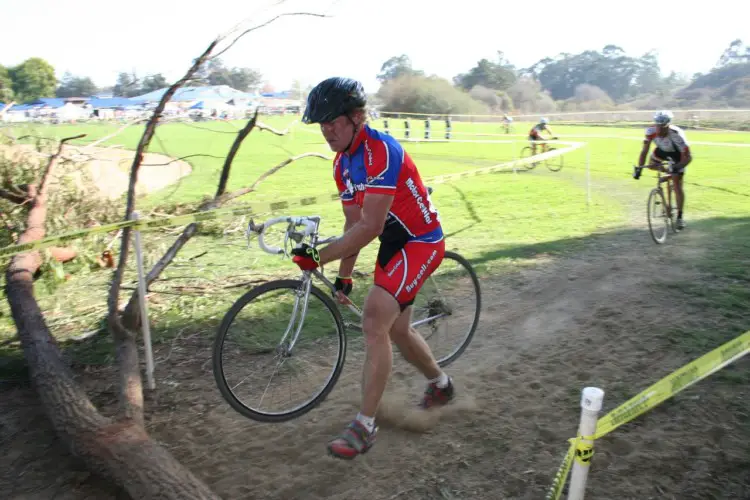
Don Myrah emerges after a decade of retirement to race his Alan-built glued and screwed Guerciotti cyclocross bike. © A. Yee / Cyclocross Magazine
Don’t Call it a Comeback
The brand now offers modern carbon and alloy frames, but hasn’t forgotten its history. In 2015, we reviewed the brand’s top-end Super Cross frame, a carbon stunner with a paint job that mimics the company’s alloy lug and carbon tubed cyclocross frames from decades ago.
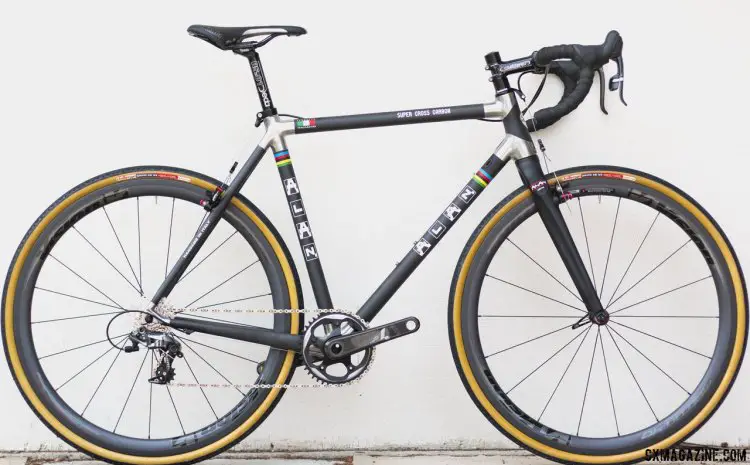
The winningest cyclocross bike brand is back, and the Alan Super Cross carbon cyclocross bike is a modern tube-to-tube construction but features a retro aluminum lugged look. © Cyclocross Magazine
On the first day of title racing at the 2018 Cyclocross National Championships in Reno, NV, Pete Dahlstrand reminded us that the original bonded alloy cyclocross frames still have a few wins left in them. Dahlstrand lined up at the back of the Masters 70+ race on Wednesday, rolled down the starting straight following wheels, but wasn’t content to remain at the back.
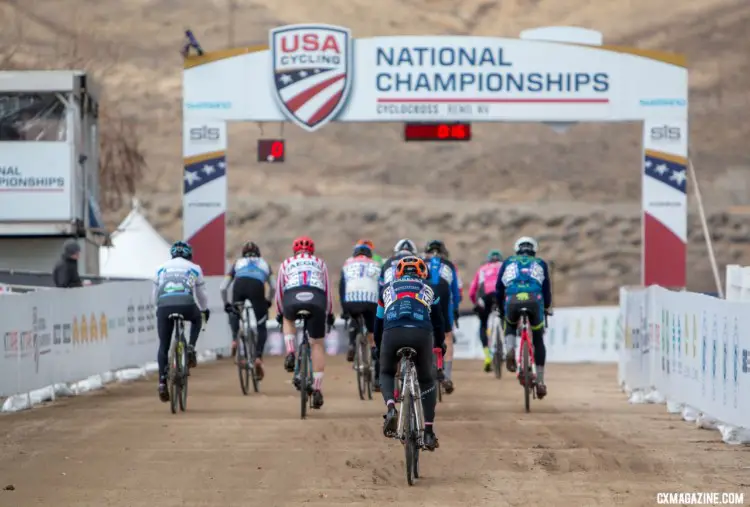
Peter Dahlstrand won Masters 80-84 after starting at the back. 2018 Cyclocross National Championships. © A. Yee / Cyclocross Magazine
Dahstrand revved up his 80-year-young engine and soon pushed past racers so hard he threw up.
He soldiered on though, on a course he described as “a good course” with a “a lot of stuff that’s really difficult, not only physically but skill-wise.”
Dahlstrand’s effort was rewarded with the 80-84 Masters National Championship.
It wasn’t his first win. Dahlstrand also took a victory in the 60+ category at the 2000 Cyclocross Nationals in Overland Park, Kansas. (Back then, the now-retired Tim Johnson won the Men’s Elite, and Katie Compton raced but actually didn’t win, finishing seventh in the Women’s Elite behind Alison Dunlap. Seems like so long ago.)
Two National Championship wins, 17 years apart. What brought Dahlstrand back to the top?
“I had a heart bypass a long time ago and it kind of took the top off my racing.” -Dahlstrand after winning his 2018 National Championship
Dahlstrand made this year’s race partly because it’s a three-hour drive from his home in Berkeley, California. Berkeley was also home to the first-ever USCF (Now USA Cycling) Cyclocross Championships in 1975.
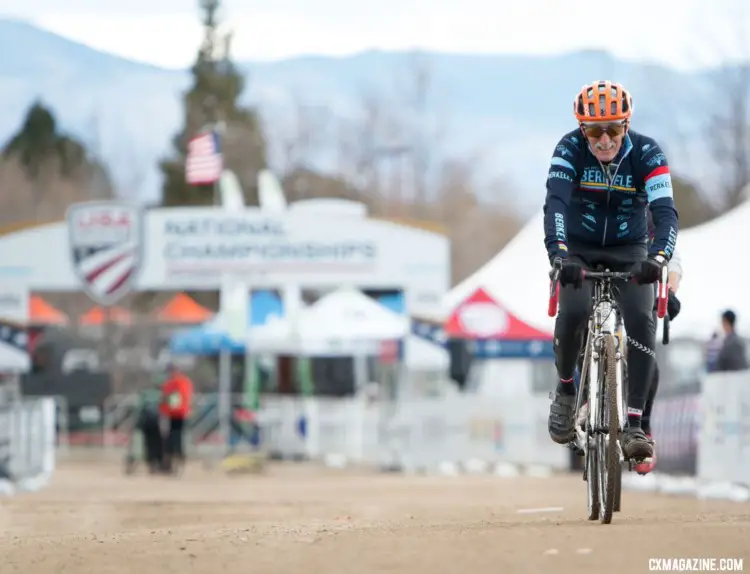
Peter Dahlstrom won the 80+ race in Reno. 2018 Cyclocross National Championships. © A. Yee / Cyclocross Magazine
Forty two years later, Berkeley still has a national cyclocross champ riding through its hills.
The Bike: An Oldie But Goodie, With Bits From Today
This is a bike profile after all, so let’s take a look at Dahlstrand’s actual bike.
Dahlstrand started racing cyclocross in 1984, bought an Alan in 1986 and has been using it ever since, piloting it to the 2000 title and every cyclocross start he’s had since.
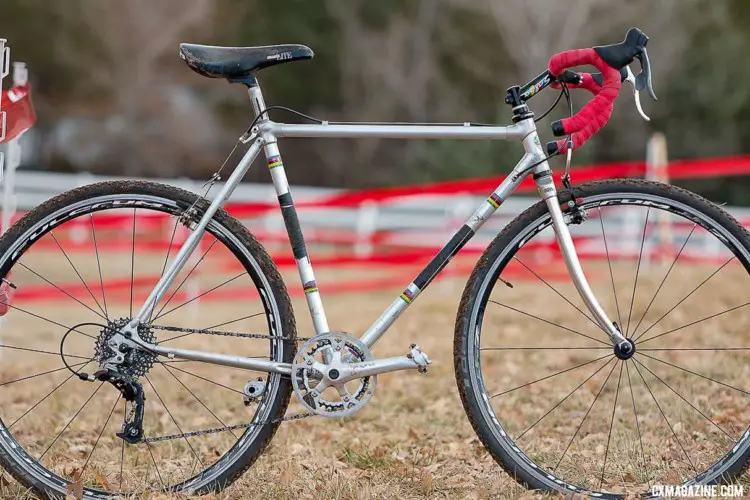
It seems appropriate that Pete Dahlstrand won Masters 80-84 on an Alan cyclocross bike from the 80s. 2018 Cyclocross National Championships. © A. Yee / Cyclocross Magazine
Dahlstrand says he has over a 100 races on the bike over the years, but recently, it hasn’t seen much use due to his time away from racing.
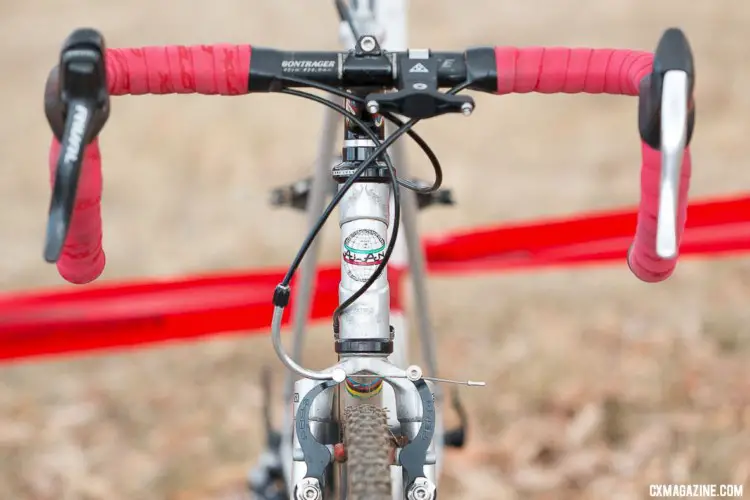
It’s a radio station that doesn’t discriminate between hits from the 80s, 90s, 2000s and today. Pete Dahlstrand’s Masters 80-84 winning 1986 Alan cyclocross bike. 2018 Cyclocross National Championships. © A. Yee / Cyclocross Magazine
His Alan is much like a radio station, playing both original 80s classics mixed in with hits from the 90s, 2000s and today.
In the more than 30 years he has raced the bike, it has been re-imagined a few times. “I haven’t raced ’cross in ten years so I just got this going again about three months ago.” Dahlstrand told Cyclocross Magazine. “I had a heart bypass a long time ago and it kind of took the top off my racing.”
The frame is an Alan cyclocross model from 1986 made of aluminum, which makes it one of the earliest examples of production aluminum cyclocross bikes. Like most Alan frames from that era, Dahlstrand’s features the “glued and screwed” method of lugged construction the Italian company pioneered, which relied on threaded lugs and an adhesive taken from the aerospace industry.
“I’m not a sprinter, I’m not real strong, and it handles real nice.”
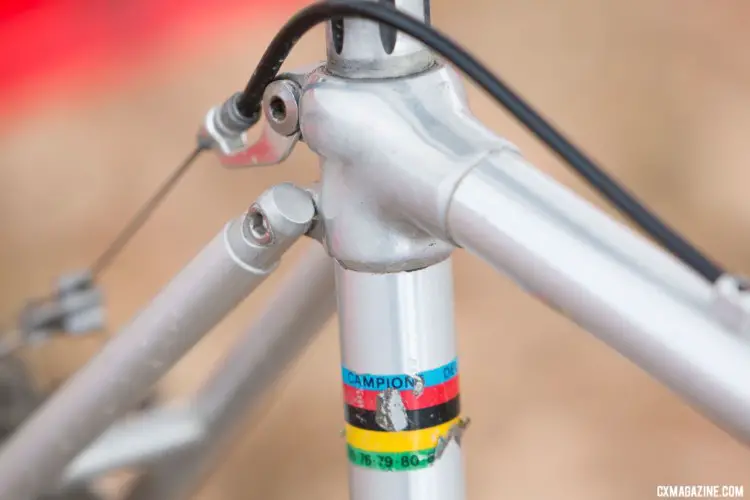
“Glued and Screwed” can be taken literally on these frames, with tubes literally screwed together or bonded in lugs. Pete Dahlstrand’s Masters 80-84 winning 1986 Alan cyclocross bike. 2018 Cyclocross National Championships. © A. Yee / Cyclocross Magazine
This construction method was not renowned for yielding a stiff frame, but instead was tuned to offer up a smooth, soft riding, comfortable platform that riders like Dahlstrand found sublime. “I’m not a sprinter, I’m not real strong, and it handles real nice,” he said of his frame.
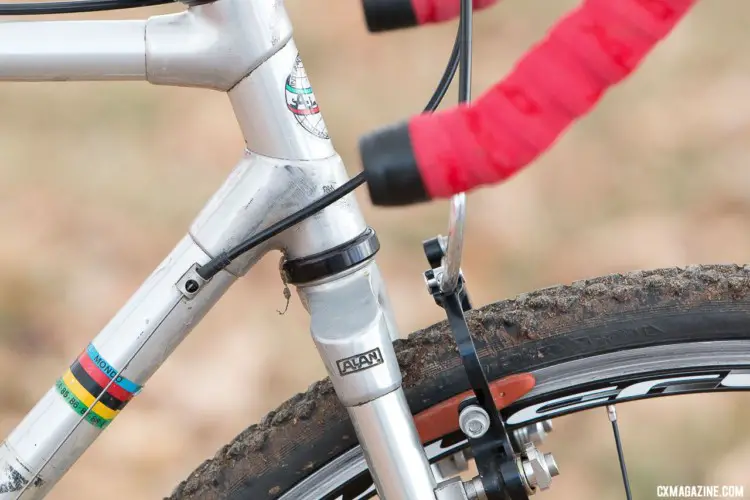
In 1986 there were no integrated shifters, so the cable stops rather than shifter bosses on the down tube indicate the bike was intended to be set up with bar end shifters. Pete Dahlstrand’s Masters 80-84 winning 1986 Alan cyclocross bike. 2018 Cyclocross National Championships. © A. Yee / Cyclocross Magazine
Think he’s just saying that because it was all he had in Reno? Dahlstrand had a titanium cyclocross bike in the pits, but preferred to ride his trusty Alan.
His bike features the original lugged aluminum fork, which would have originally been paired with a threaded headset and a quill stem. Dahlstrand, however, retrofitted a Cane Creek Aheadset to the bike and mounted his bars using a Salsa 1″ threadless mountain bike stem.
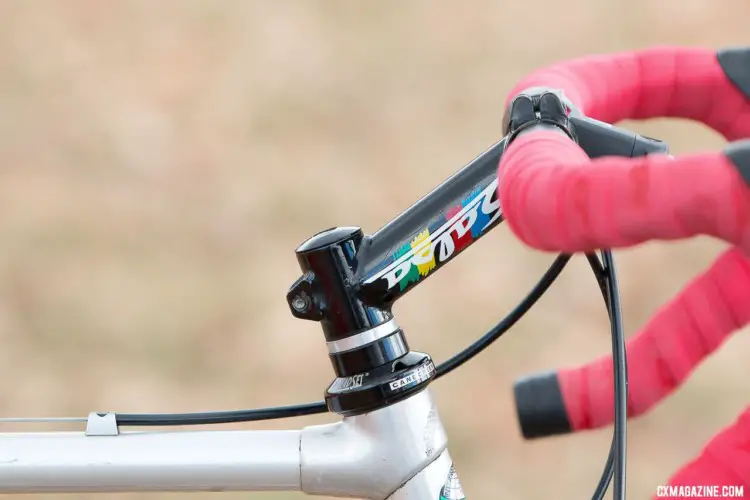
Originally, the headset would have been threaded and the bars would be attached with a quill stem. Dahlstrand used a 1” Salsa stem and Cane Creek Aheadset to update his front end. Pete Dahlstrand’s Masters 80-84 winning 1986 Alan cyclocross bike. 2018 Cyclocross National Championships. © A. Yee / Cyclocross Magazine
His handlebars are a set of older Bontrager ø26.00mm ergo grip bars in a narrow 40cm width wrapped in red XLC cork tape.
One interesting feature is the Topeak CageMount attached to his handlebar. The Alan frame is a dedicated race frame without bottle bosses on the seat or down tubes, forcing Dahlstrand to get creative in order to carry water while training. He took off the cage for the race, however.
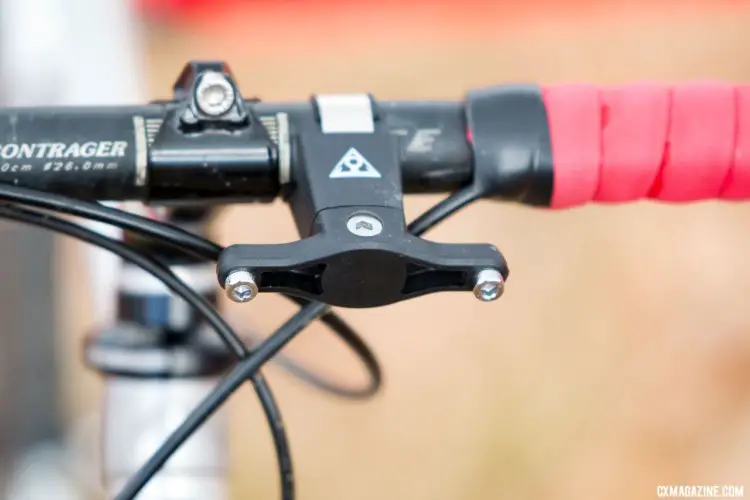
Without any braze ons for bottle cages, the Topeak CageMount allows Dahlstrand to carry water on training rides. Pete Dahlstrand’s Masters 80-84 winning 1986 Alan cyclocross bike. 2018 Cyclocross National Championships. © A. Yee / Cyclocross Magazine
The bike features a period-correct fluted seatpost and a well worn Vetta Lite saddle that shows the years of training and racing.
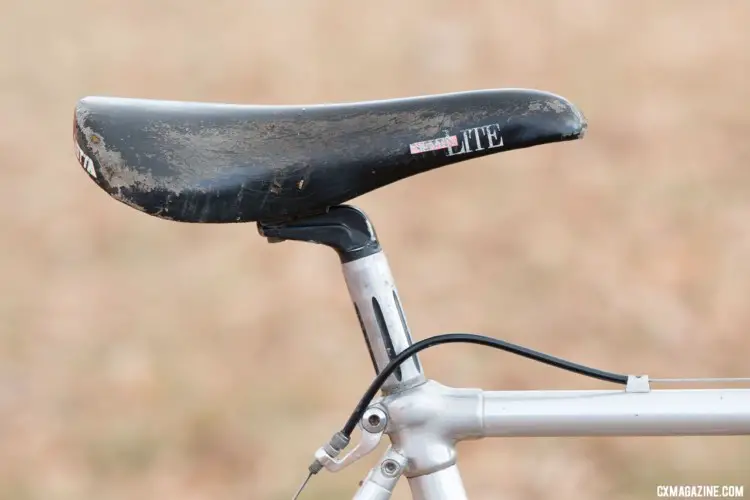
Some of the few period-correct parts are the fluted seat post and well worn Vetta Lite saddle. Pete Dahlstrand’s Masters 80-84 winning 1986 Alan cyclocross bike. 2018 Cyclocross National Championships. © A. Yee / Cyclocross Magazine
While the bike would have originally featured bar end shifters, Dahlstrand outfitted it with a SRAM Rival 10-speed shifter and a current generation Rival 22 long cage rear derailleur, with an 11-32 SRAM PG-1070 cassette and SRAM PC-1071 chain.
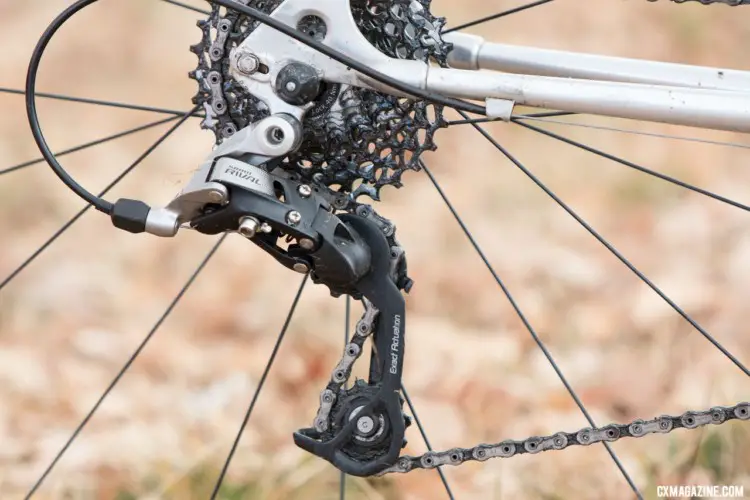
Dahlstrand’s drivetrain features a SRAM Rival 22 long cage rear derailleur. No clutch needed when you’ve got such a smooth-riding frame! Pete Dahlstrand’s Masters 80-84 winning 1986 Alan cyclocross bike. 2018 Cyclocross National Championships. © A. Yee / Cyclocross Magazine
Curiously, he did not use a clutch derailleur despite a Rival 22 variant being available and compatible with the drivetrain. His Sugino square taper crankset was set up 1x with a 34-tooth Sugino chainring and a homemade chain guard, which was originally a 48 tooth Shimano Biopace chainring. This isn’t the first time we have seen such a solution, Sven Nys‘ 2015 Trek Boone featured a machined down Dura Ace chainring, and racers in the 80s and 90s often relied on two machined chainrings as chainguards for 1x drivetrains.
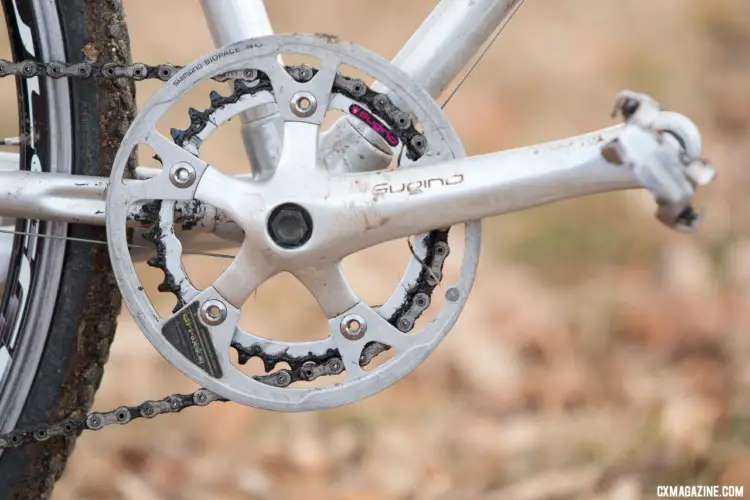
Biopace were standard equipment on late 80s bikes but fell out of favor. With a bit of machining, they make great chain guards to keep the chain on the 34t chain ring. Pete Dahlstrand’s Masters 80-84 winning 1986 Alan cyclocross bike. 2018 Cyclocross National Championships. © A. Yee / Cyclocross Magazine
One of the more recent changes to Dahlstrand’s bike is the Shimano PD-M540 SPD pedals, swapped in for his previous Time ATAC pedals. “I used to use Time and now I’m using Shimano,” he told us, “They seem to work pretty well, better than Time.”
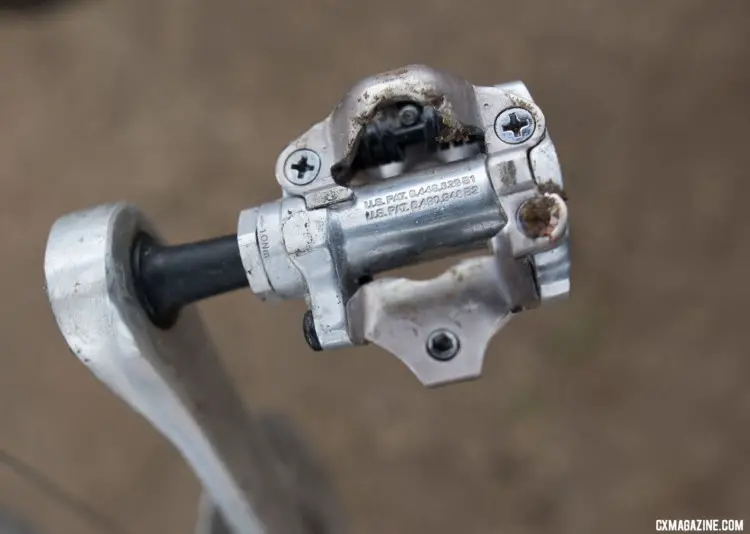
Pete Dahlstrand’s Masters 80-84 winning 1986 Alan cyclocross bike featured modern Shimano M540 SPD pedals. 2018 Cyclocross National Championships. © A. Yee / Cyclocross Magazine
Dahlstrand’s right brake lever is integrated into the SRAM shifter and paired with a titanium-dressed SRP CNC-machined cantilever brakes and KoolStop Black Eagle 2 pads. The SRP units, like the similarly designed but heavier Hogan brakes, were famous for pad and mud clearance and infamous for their lack of stopping power.
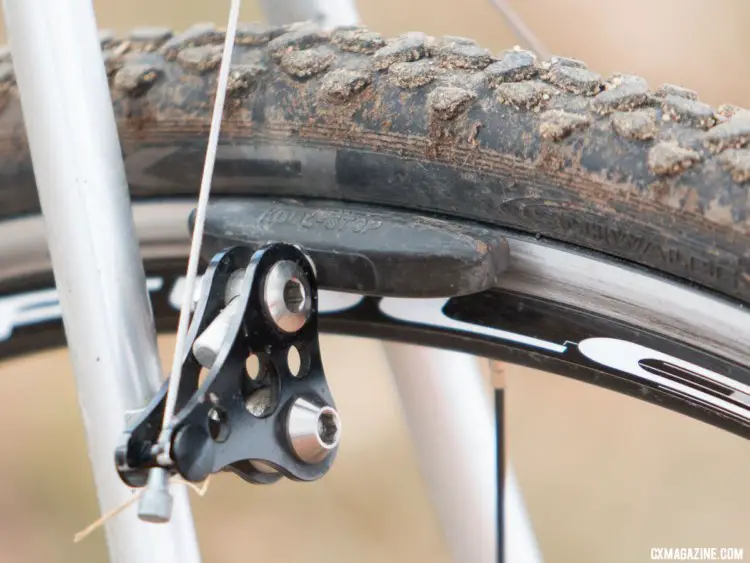
SRP tiatnium bolt-dressed wide-profile cantilevers are great for mud clearance, at the expense of braking power. Pete Dahlstrand’s Masters 80-84 winning 1986 Alan cyclocross bike. 2018 Cyclocross National Championships. © A. Yee / Cyclocross Magazine
The left brake lever is an older Shimano standalone unit paired with a Paul MiniMoto linear pull brake set, using the stock KoolStop Salmon Thinline pads. Both grab onto the last generation Fulcrum 7 Racing aluminum clinchers.
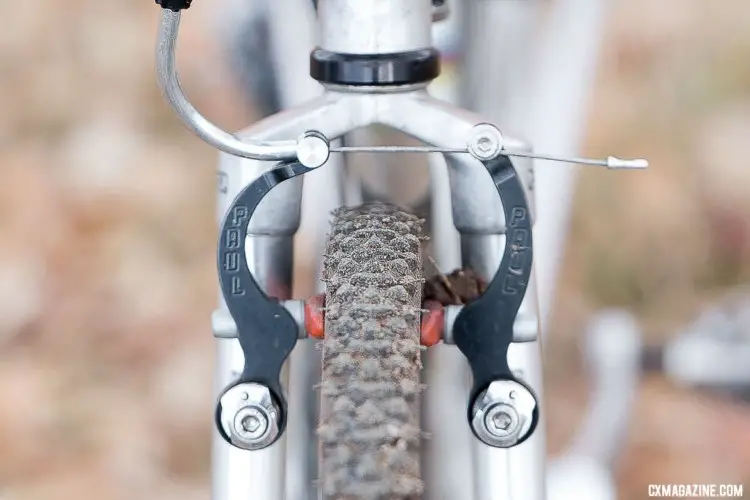
Paul MiniMoto linear pull brakes with KoolStop Salmon pads provide stopping power in the front. Note the small size of the fork crown. No 40mm gravel tires here! Pete Dahlstrand’s Masters 80-84 winning 1986 Alan cyclocross bike. 2018 Cyclocross National Championships. © A. Yee / Cyclocross Magazine
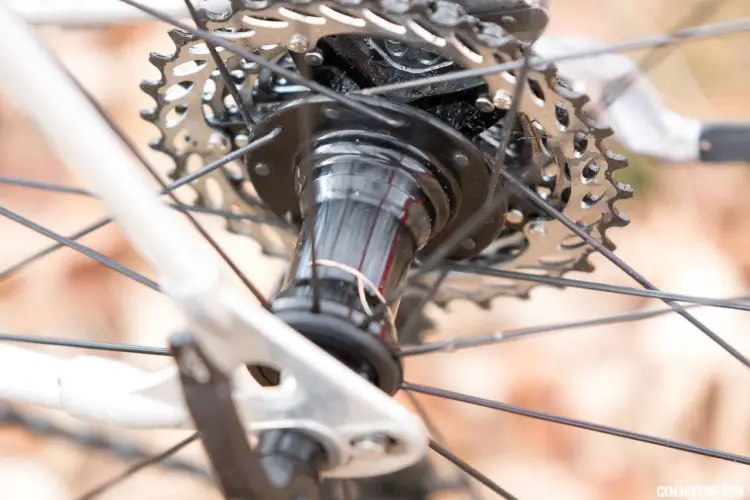
Fulcrum 7 Racing wheels use 2:1 lacing on the back which allows for more equal spoke tension. We’re not sure if he spread the dropouts to fit the 130mm rear wheel or modified them to fit 126mm dropouts. Pete Dahlstrand’s Masters 80-84 winning 1986 Alan cyclocross bike. 2018 Cyclocross National Championships. © A. Yee / Cyclocross Magazine
These Campagnolo-made wheels feature 2:1 spoke lacing in the rear and Campagnolo’s OS aluminum axle. For Reno, Dahlstrand selected Schwalbe CX Pro Light 30mm tubed clinchers with roughly 35psi. We reviewed the 26″ version of the CX Pro in 2011 and found them to be the narrowest tire we’ve ever tested.
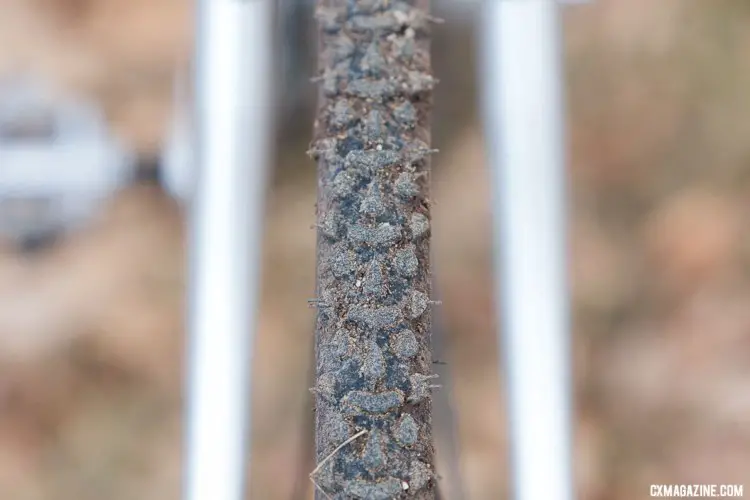
Dahlstrand ran his rear tire backwards to gain driving traction. We have seen this in the past but the practice has fallen out of favor in recent years. Pete Dahlstrand’s Masters 80-84 winning 1986 Alan cyclocross bike. 2018 Cyclocross National Championships. © A. Yee / Cyclocross Magazine
Everywhere you looked in Reno, you saw carbon frames, flat mount hydraulic disc brakes, carbon rims and handmade tubular tires. Yet Dahlstand has been around long enough to have seen it all and know that most of the time, it’s the rider who makes it to the start and finish lines who wins the championship.
Narrow tires, inner tubes, wide-profile cantis and a 1986 lugged and bonded frame? For Pete Dahlstand, it’s a winning combo once again.
Peter Dahlstand’s 2018 National Championship-Winning 1986 Alan Cyclocross Bike Specs:
Frame: Alan cyclocross, bonded lugged aluminum, 1″ head tube, threaded bottom bracket, non-replacable derailleur hanger.
Fork: Alan bonded aluminum, 1″ threaded (converted threadless) steerer
Shifter: SRAM Rival DoubleTap 10 speed
Brake Caliper: Paul MiniMoto, KoolStop Salmon Thinline pads front/SRP wide cantilever rear, KoolStop Black Eagle 2 pads rear.
Rear Derailleur: SRAM Rival 22 long cage
Crankset: Sugino, 110 BCD
Chainrings: Sugino 34t, Shimano BioPace 48t machined into chainguard, 110 BCD
Cassette: SRAM PG-1070
Chain: SRAM PC-1071
Stem: Salsa 1” threadless MTB
Handlebar: Bontrager Race ergo grip, ø26.0mm, 40cm
Seatpost: Alloy, 20mm setback
Saddle: Vetta Lite
Pedals: Shimano PD-M540 SPD
Rims: Fulcrum 7 Racing
Tires: Schwalbe CX Pro Light, 700x30mm, tubed clincher
Peter Dahlstand’s 2018 National Championship-Winning 1986 Alan Cyclocross Bike Photo Gallery:























